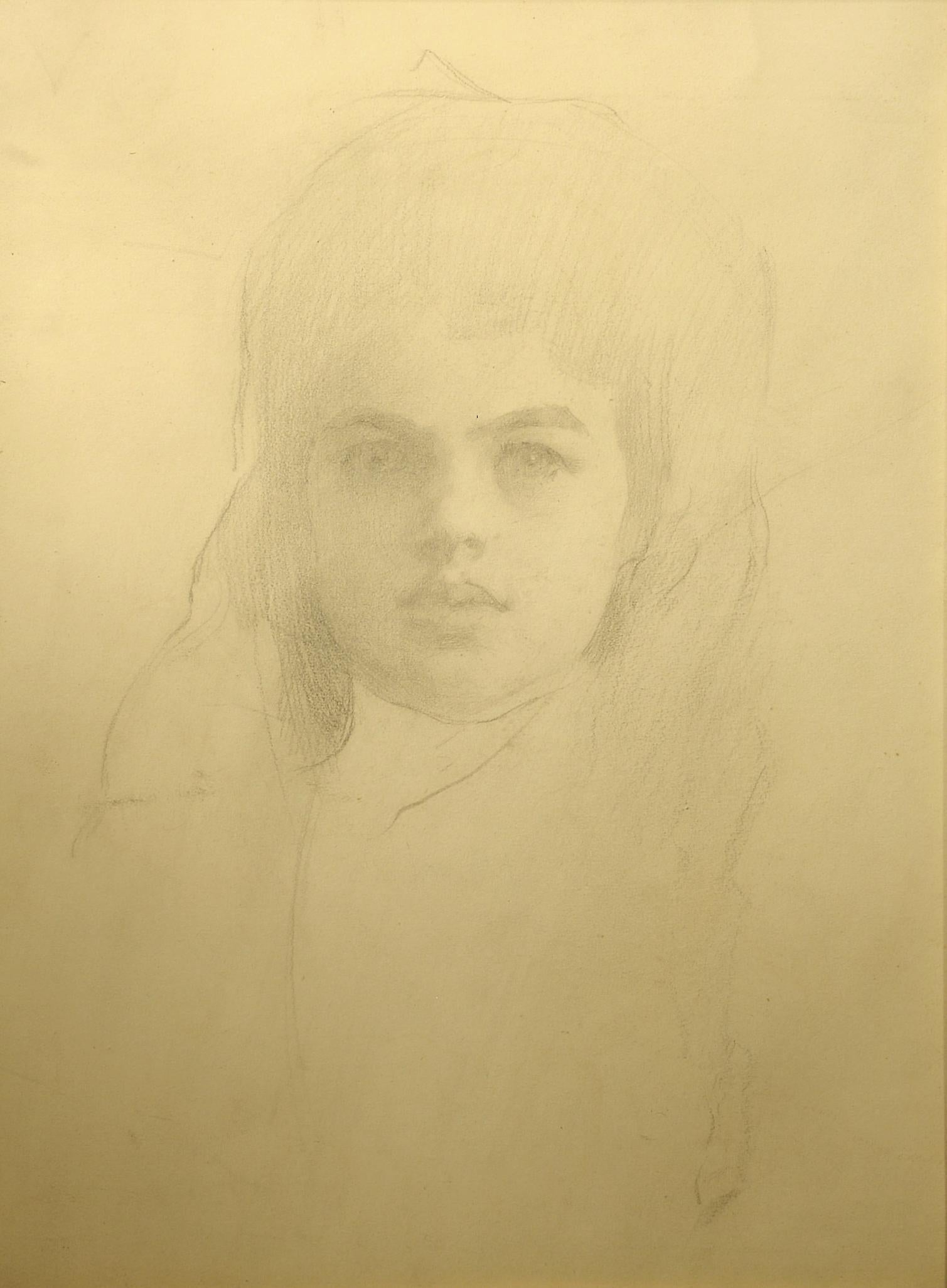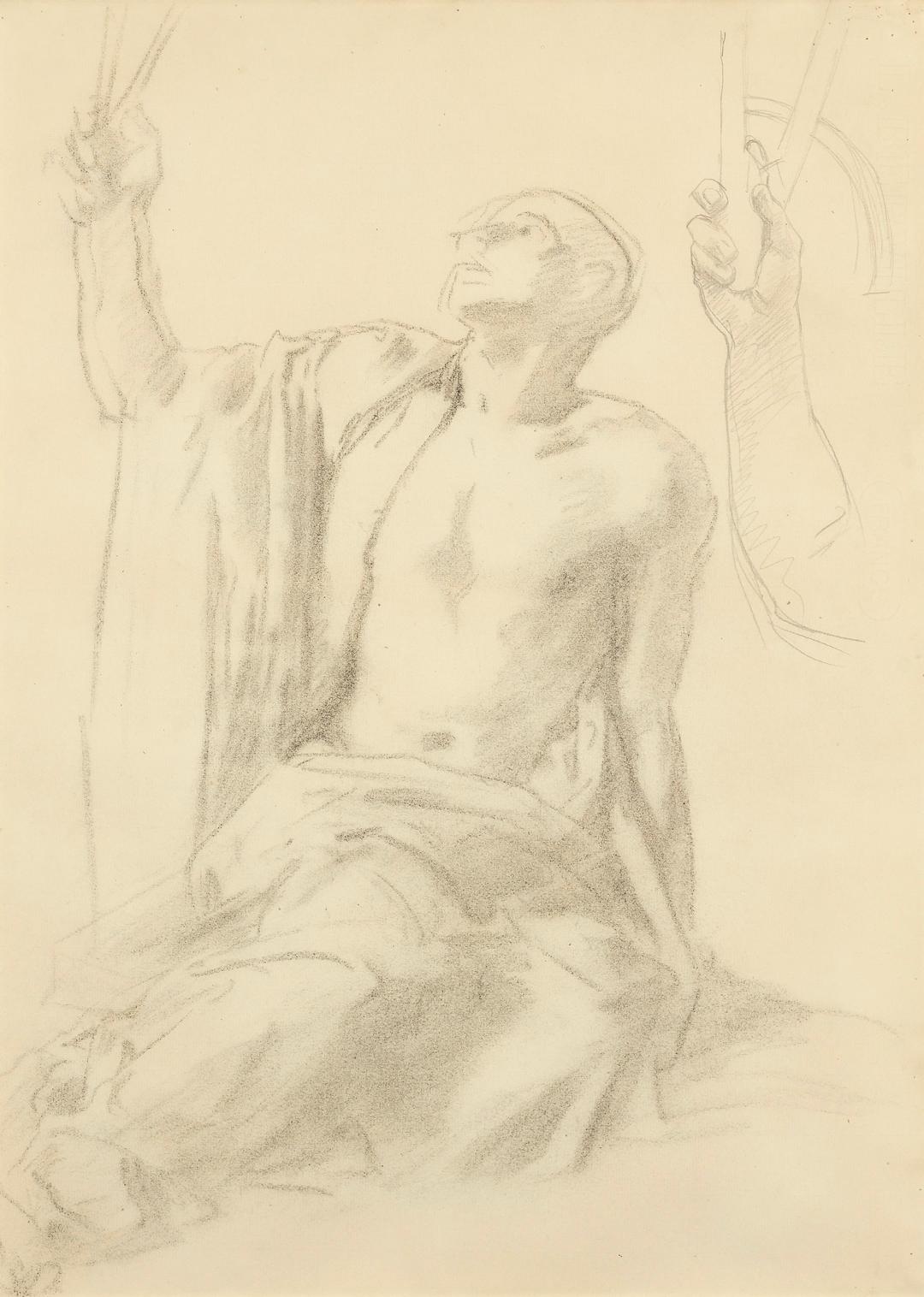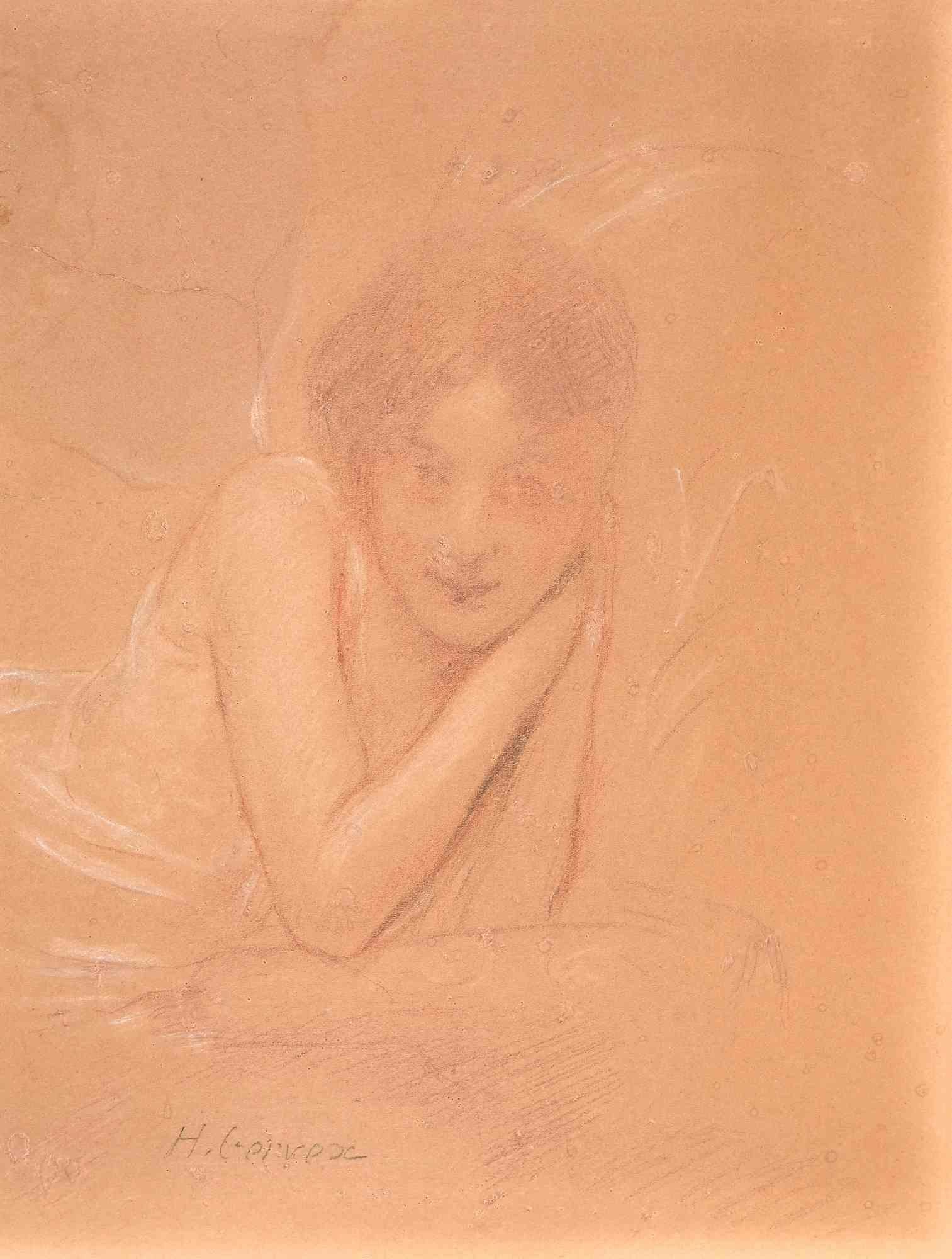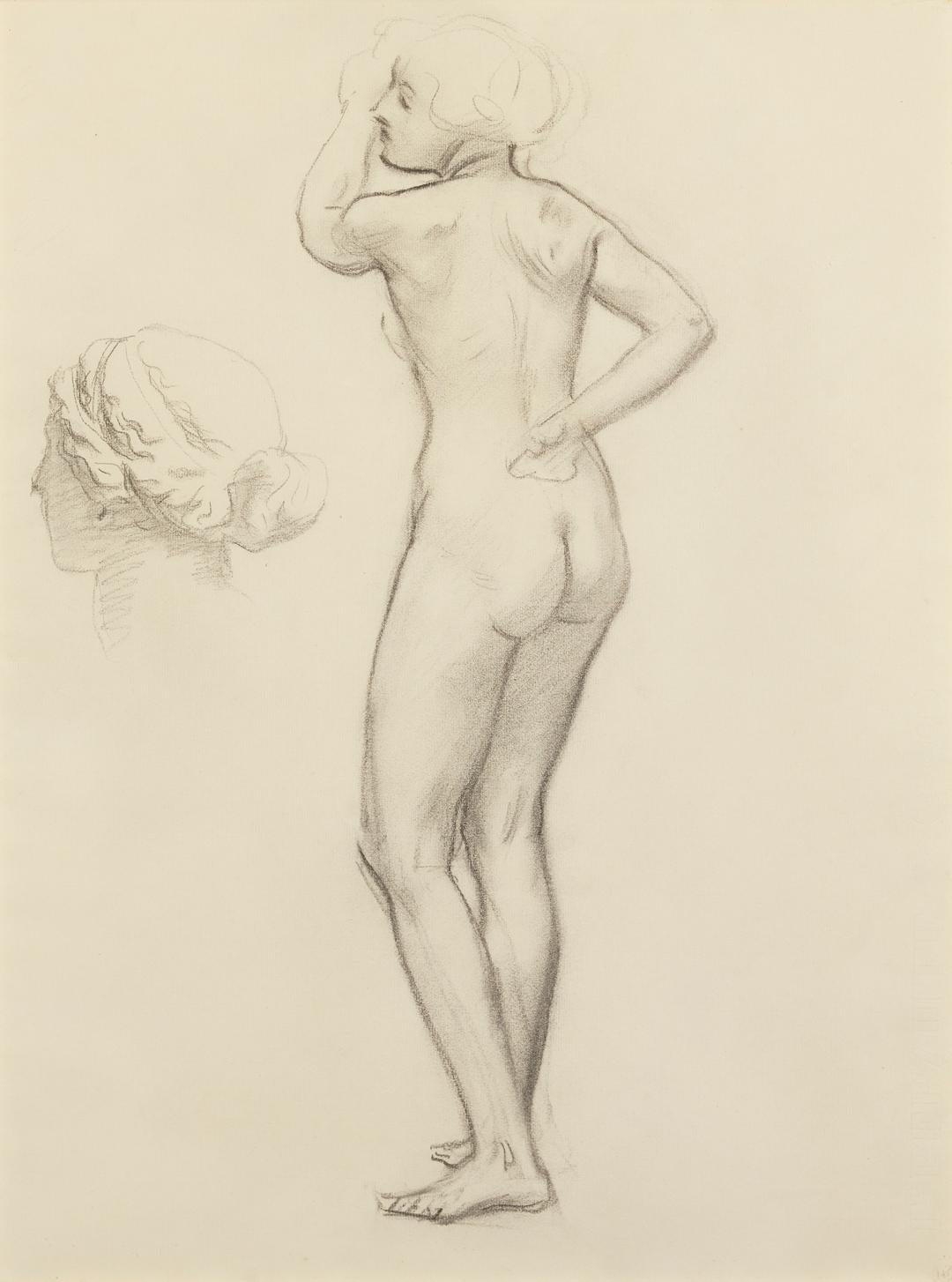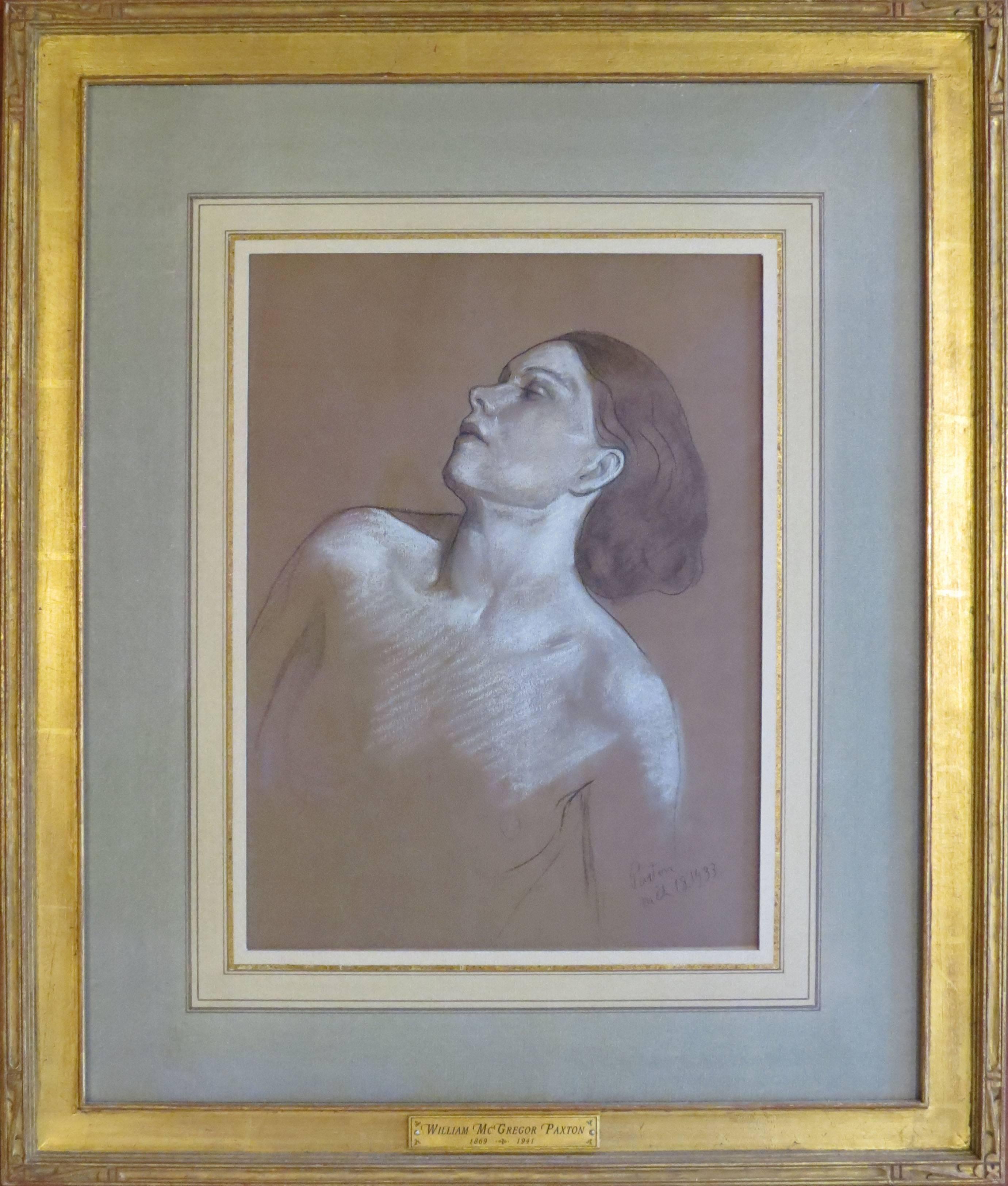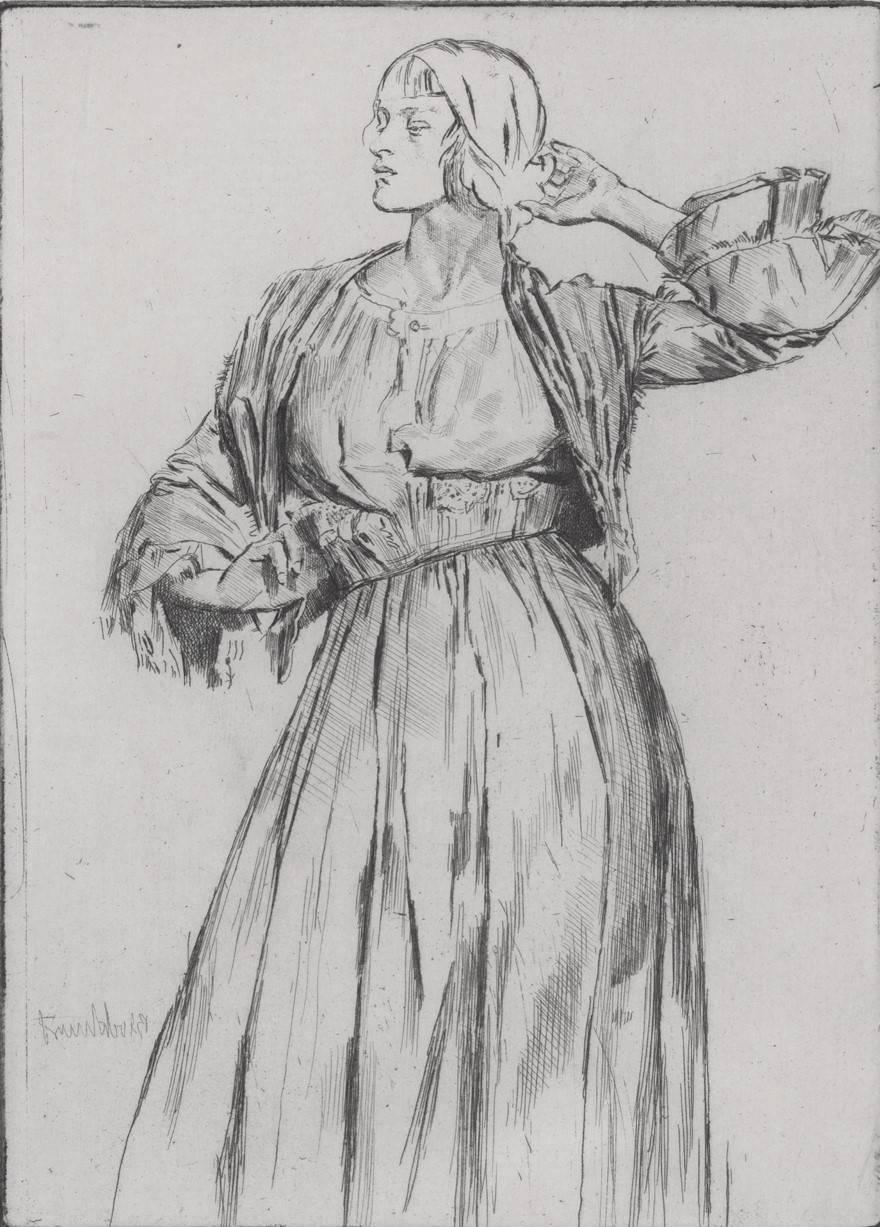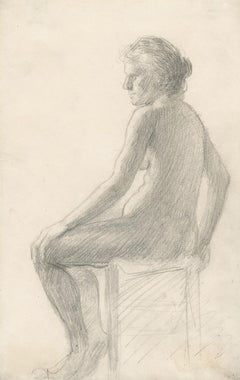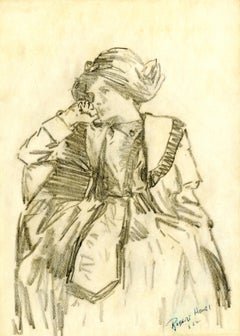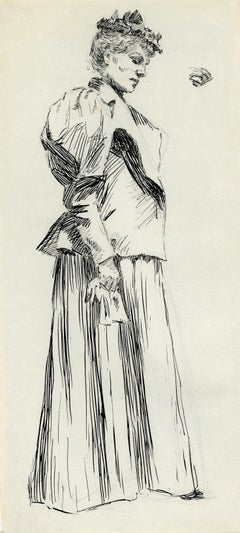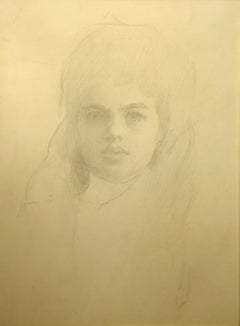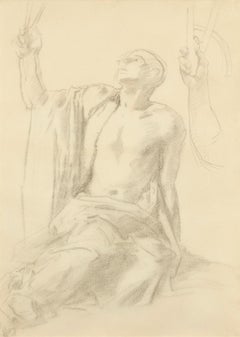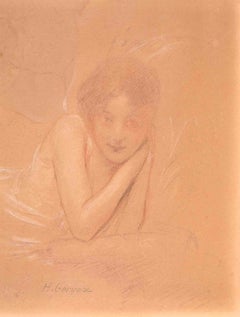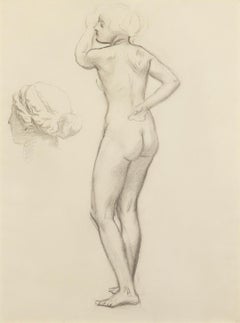Items Similar to Preliminary Study for the painting Rose and Gold, 1913
Want more images or videos?
Request additional images or videos from the seller
1 of 8
William McGregor PaxtonPreliminary Study for the painting Rose and Gold, 19131913
1913
$1,200
£907.05
€1,042.36
CA$1,670.99
A$1,858.91
CHF 974.46
MX$22,715.44
NOK 12,408.59
SEK 11,680.97
DKK 7,780.85
Shipping
Retrieving quote...The 1stDibs Promise:
Authenticity Guarantee,
Money-Back Guarantee,
24-Hour Cancellation
About the Item
Preliminary Study for the painting Rose and Gold, 1913
Graphite on paper, 1913
Signed in pencil lower left (see photo)
Titlted "Lizzy Young" in pencil upper left (see photo)
Lizzy was a modle that Paxton depicts numerous times.
The painting that this drawing is related to, is illustrated in Lee & Krause, William McGregor Paxton, 1869-1941, Plate 32, text on page 132. The painting was formerly in the collection of Victor Spark and the Honorable Paul Buchanan. It is currently in a Texas Collection.
Provenance: Private Collection, Florida
William McGregor Paxton (June 22, 1869 – 1941) was an American painter and instructor who embraced the Boston School paradigm and was a co-founder of The Guild of Boston Artists. He taught briefly while a student at Cowles Art School, where he met his wife Elizabeth Okie Paxton, and at the Museum of Fine Arts School in Boston. Paxton is known for his portraits, including those of two presidents—Grover Cleveland and Calvin Coolidge—and interior scenes with women, including his wife. His works are in many museums in the United States.
Early life
He was born on June 22, 1869, in Baltimore to James and Rose Doherty Paxton. William's father moved the Paxton family and established a catering business in Newton Corner, Massachusetts, in the mid-1870s.
Education
Paxton attended Cowles Art School on a scholarship he attained at the age of 18. He studied with Dennis Miller Bunker and Cowles and then went to Paris to study under Jean-Léon Gérôme, at École des Beaux-Arts.] Maryhill Museum of Art said he also studied at Académie Julian in Paris. He returned to Cowles and studied with Joseph DeCamp, who also taught Elizabeth Vaughan Okie She became Paxton's student and then his wife.
Marriage
Paxton became engaged in 1896 to Elizabeth Vaughan Okie, and they married on January 3, 1899. They traveled to Europe together[4] and often spent their summers on Cape Cod and Cape Ann.] They lived in Newton, Massachusetts, first on Elmwood Street with his parents. About 1916 they resided or had a studio on Ipswich Street in Fenway Studios in Boston. They later purchased a house in Newton Center on Montvale Road.
Paxton's wife managed his career and modeled for many of his works, like the painting in which she was dressed for the ball. "William McGregor Paxton... benefited from an art-savvy wife who supported his career, using her energy in the bet that his offered the more secure future," said author and art historian Rena Tobey. The couple had no children.
Career
Paxton taught from 1906 to 1913 at the Museum of Fine Arts School and painted briefly at Fenway Studios in Boston.] He worked at the Harcourt Street Studios in Boston and when it burned in 1904 he lost close to 100 paintings. He then went to the Fenway Studios for a brief period but then moved on to the Riverway Studios, also in Boston. He is primarily known for his portraits and painted both Grover Cleveland] and Calvin Coolidge. Maryhill Museum of Art says of his artistry, "Paxton was well known for the attention he gave to the effects of light and detail in flesh and fabric. His works often present idealized views of women, such as this portrait (The Red Fan) of his wife Elizabeth", like Henry James's portrayal of women in his novels The Portrait of a Lady (1881) or The American (1877). His models, often daughters and wives of his patrons, were depicted as refined, cultured women of "conspicuous leisure", and equated with the "precious aesthetic objects surround them", like the women of Thorstein Veblen's Theory of the Leisure Class (1899) who reflect the wealth of their husbands or fathers. He crafted elaborate compositions with models in his studio, using props that appear in several paintings.
Paxton and several other Bostonian artists were inspired by Johannes Vermeer. The Metropolitan Museum of Art says of Paxton's Tea Leaves (1909) in their collection:
In a windowless parlor permeated by soft light, a dreamy atmosphere, and the sounds of silence, two elegant women pass the time by doing very little or nothing at all. Paxton hints at a narrative, but he asks that the viewer invent it, recapitulating the ambiguity of Vermeer's paintings, which he admired.[13]
Paxton employed a technique where only one area in his compositions was entirely in focus, while the rest was somewhat blurred, something he called "binocular vision" and credited to Vermeer. He began to employ this system in his own work, including The New Necklace, where only the gold beads are sharply defined while the rest of the objects in the composition have softer, blurrier edges.[15]
Paxton is one of the key figures in the Boston School of painting and a co-founder of The Guild of Boston Artists with Frank Weston Benson and Edmund Charles Tarbell. Between 1926 and 1927, he was interviewed by Dewitt Lockman with 85 other artists and architects associated with the National Academy of Design. Records from the interview are held at the New York Historical Society and the Archives of American Art.[16] Paxton was made a full member of the National Academy of Design in 1928.
Paxton died of a heart attack when he was painting his wife in their Montvale Road living room. He was 72 years of age. An exhibition was held in his memory at the Museum of Fine Arts, Boston from November 19 through December 14, 1941. His papers—including sketches, correspondence, and photographs—are held at the Archives of American Art at the Smithsonian Institution in Washington, D.C.
Courtesy Wikipedia
- Creator:William McGregor Paxton (1869 - 1941, American)
- Creation Year:1913
- Dimensions:Height: 12 in (30.48 cm)Width: 8.75 in (22.23 cm)
- Medium:
- Movement & Style:
- Period:
- Condition:
- Gallery Location:Fairlawn, OH
- Reference Number:Seller: FA85201stDibs: LU14013121952
About the Seller
5.0
Recognized Seller
These prestigious sellers are industry leaders and represent the highest echelon for item quality and design.
Gold Seller
Premium sellers maintaining a 4.3+ rating and 24-hour response times
Established in 1978
1stDibs seller since 2013
798 sales on 1stDibs
Typical response time: <1 hour
Associations
International Fine Print Dealers Association
- ShippingRetrieving quote...Shipping from: Akron, OH
- Return Policy
Authenticity Guarantee
In the unlikely event there’s an issue with an item’s authenticity, contact us within 1 year for a full refund. DetailsMoney-Back Guarantee
If your item is not as described, is damaged in transit, or does not arrive, contact us within 7 days for a full refund. Details24-Hour Cancellation
You have a 24-hour grace period in which to reconsider your purchase, with no questions asked.Vetted Professional Sellers
Our world-class sellers must adhere to strict standards for service and quality, maintaining the integrity of our listings.Price-Match Guarantee
If you find that a seller listed the same item for a lower price elsewhere, we’ll match it.Trusted Global Delivery
Our best-in-class carrier network provides specialized shipping options worldwide, including custom delivery.More From This Seller
View AllSide View Seated Female Nude
By Frank Duveneck
Located in Fairlawn, OH
Side View Seated Female Nude
Graphite on paper, c. 1890's
Unsigned
Provenance:
Rookwood Pottery Factory Collection, Cincinnati
Spanierman Gallery, New York (label)
Drawings from the...
Category
1890s American Impressionist Nude Drawings and Watercolors
Materials
Graphite
Side View Seated Female Nude
By Frank Duveneck
Located in Fairlawn, OH
Side View Seated Female Nude
Graphite on paper, c. 1890's
Unsigned
Provenance:
Rookwood Pottery Factory Collection, Cincinnati
Spanierman Gallery, New York (label)
Drawings from the...
Category
1890s American Impressionist Nude Drawings and Watercolors
Materials
Graphite
Portrait of a resting young lady (Marjorie Organ)
By Robert Henri
Located in Fairlawn, OH
Portrait of a resting young lady (Marjorie Organ)
Black chalk on paper. c. 1907
signed in ink by Henri's nephew, John C. LeClair, the executor of the Henri estate
"Robert Henri JLC"
Note: The sitter for this portrait is depicted in two drawings of similar size, illustrated in Chapellier Galleries Inc., Robert Henri 1865-1929, 1976, nos. 15 & 16.
Please see the attached photo of Marjorie Organ, Henri's second wife
Condition: Excellent
Image/Sheet size: 10 3/8 x 7 1/2 inches
Provenance: Estate of the Artist
John C. LeClair, Estate Adminitrator
Private Collection, Pawling, New York
Biography
Robert Henri was born Robert Henry Cozad in Cincinnati, Ohio, on June 24, 1865, the son of a professional gambler and real estate developer. The family lived in Nebraska and Colorado, but fled east when the father shot and killed a rancher over a land dispute and was indicted for manslaughter. They changed their last name because of the ensuing scandal and eventually settled in Atlantic City, New Jersey, during the early 1880s.
In 1886 Henri enrolled at the Pennsylvania Academy of the Fine Arts in Philadelphia, where he studied under Thomas Anshutz, Thomas Hovenden...
Category
Early 1900s American Impressionist Figurative Drawings and Watercolors
Materials
Graphite
Standing Woman in Profile
By Frederick Carl Frieseke
Located in Fairlawn, OH
Standing Woman in Profile
Pen and ink drawing, c. 1900
Unsigned
Estate authentication verso by Frances Frieseke Kilmer (Mrs. Kenton Kilmer, 1914-1998) (see photo)
Condition: Excellen...
Category
Early 1900s American Impressionist Figurative Drawings and Watercolors
Materials
Ink
Untitled (Seated Young Woman)
Located in Fairlawn, OH
Untitled (Seated Young Woman)
Graphite on Veritable Papier d'Arches wove paper, 1970
Signed and dated lower right (see photo)
Condition: Excellent
Image/sheet size: 15 x 11 1/4 inch...
Category
1970s American Realist Figurative Drawings and Watercolors
Materials
Graphite
Woman with Bicycle: Two Views
By Frank Duveneck
Located in Fairlawn, OH
Woman with Bicycle: Two Views
Graphite on paper, c. 1890
Unsigned
Graphite study of standing female nude verso
Provenance:
Rookwood Pottery Factory Collection, Cincinnati
Spanierman Gallery, New York (label)
Drawings from the sketchbook are in the collections of the Munson Williams Proctor Institute in Utica, New York and the Picker Art Gallery, Colgate University, Hamilton, New York.
A sister drawing from the same sketchbook was sold at Cowman’s Auction, Cincinnati, October 6, 2018. Accompanied by a letter from the Spanierman Gallery, dated 1997, stating that the drawing is from a sketchbook that was held in the Rookwood Factory Collection.
Sister drawing provenance: Provenance: Terry DeLapp...
Category
1890s American Realist Figurative Drawings and Watercolors
Materials
Graphite
You May Also Like
"Portrait of a Girl, " attrib. to Edmund Tarbell, graphite, portrait, 1900-1910
Located in Wiscasset, ME
Born in Groton, Massachusetts in 1862, impressionist painter Edmund Charles Tarbell studied with George H. Bartlett at the Massachusetts Normal Art School, under Otto Grundmann at the School of the Museum of Fine Arts in Boston and in 1883, entered the Académie Julian to study under Gustave Boulanger and Jules Joseph Lefebvre. In 1884, his education included a Grand Tour to Italy and the following year to Belgium, Germany and Brittany.
Tarbell returned to Boston in 1886 where he began his career as an illustrator, private art instructor and portrait painter. He was a member of the Ten American Painters and was a leading member of a group of painters which came to be known as the Boston School.
In 1889 Tarbell assumed the position of his former mentor, Otto Grundmann, at the Museum School. His students included Bertha Coolidge, Margaret Fitzhugh Browne...
Category
Early 1900s Impressionist Portrait Drawings and Watercolors
Materials
Graphite
Figure Study For 'Science'
By John Singer Sargent
Located in New York, NY
This charcoal drawing is a preliminary study for the figure of Science, the subject that comprises the far right panel above the entrance to the library at the Museum of Fine Arts, B...
Category
1920s American Impressionist Figurative Drawings and Watercolors
Materials
Paper, Charcoal, Graphite
Price Upon Request
Portrait of Young Woman - Drawing by Henri Gervex - Early 20th Century
By Henri Gervex
Located in Roma, IT
Portrait of Young Woman is an Original Pastel Drawing, realized in the 20th Century Henri Gervex (1852-1929).
The status of preservation Good.
The artwork is depicted skillfully th...
Category
Early 20th Century Modern Figurative Drawings and Watercolors
Materials
Pastel
Study for Apollo and the Muses
By John Singer Sargent
Located in New York, NY
This is a figure and head study for the extreme right figure depicted in Apollo and the Muses, one of the magnificent ovals decorating the dome of the rotunda of the Museum of Fine A...
Category
1920s American Impressionist Figurative Drawings and Watercolors
Materials
Paper, Pencil
Price Upon Request
"Eyes Wide Open"
By William McGregor Paxton
Located in Lambertville, NJ
Born in Baltimore and raised in Newton, Massachusetts, William Paxton became a prominent late 19th, early 20th-century figure painter, especially noted for female subjects, and a key artist in the establishment of American Impressionism. Paxton also painted outdoor views of upper class life such as croquet games and hotel verandah scenes.
In Philadelphia where he lived briefly, he received so many commissions for portrait paintings that he was referred to as the "court painter of Philadelphia." Portrait subjects included Presidents Calvin Coolidge...
Category
1930s Figurative Drawings and Watercolors
Materials
Charcoal, Paper
Study for a Decoration (Marguérite).
By Gerald Leslie Brockhurst
Located in Storrs, CT
Study for a Decoration (Marguérite). 1926. Etching. Fletcher catalog 46 state ii/iii. 6 7/8 x 5 (sheet 11 3/16 x 9 1/16). 5 proofs in this state (total 76 proofs). Illustrated: Salam...
Category
Early 20th Century Modern Portrait Prints
Materials
Etching
More Ways To Browse
Arts And Crafts Painting
1913 Art
1913 Painting
Painting Of Women And Children
Antique Roses Painting
Vermeer Paintings
Antique Rose Drawing
Gold Cape
Jean Rose Painting
William Sharp
Embracing Couples Paintings
Lee Young Painting
Henry Lee
Rose Painting 1909
Watercolor Cape Cod
1910 Roses Painting
Elizabeth Miller
Ipswich Paintings
